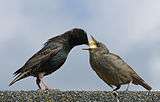Bottom feeder

A bottom feeder is usually an aquatic animal that feeds on or near the bottom of a body of water.[1] The body of water could be the ocean, a lake, a river, or an aquarium. Bottom feeder is a general term which is used particularly in the context of aquariums. Biologists often use the term benthos, particularly for invertebrates such as shellfish, crabs, crayfish, sea anemones, starfish, snails, bristleworms and sea cucumbers. However the term benthos includes all aquatic life that lives on or near the bottom, which means it also includes non-animals, such as plants and algae.
Biologists also use specific terms that refer to bottom feeding fish, such as demersal fish, groundfish, benthic fish and benthopelagic fish. Examples of bottom feeding fish species groups are flatfish (halibut, flounder, plaice, sole), eels, cod, haddock, bass, grouper, carp, bream (snapper) and some species of catfish and shark.
Biological trends
Bottom feeders are not necessarily detritivores, although there are many that are. Some bottom feeders graze along the bottom, feeding on plant material. Other bottom feeders may feed on other bottom feeders, and thus are carnivores.
Many bottom feeders are also capable of burying themselves. A variety of invertebrates are able to bury themselves, such as bristleworms, sea cucumbers, and snails. Many vertebrate bottom feeders may bury themselves, such as flatfish or stingray.
In many bottom feeders, a mechanism to deal with substrate is often necessary. In the case of some organisms such as sea cucumbers, the sand is usually passed through the body. In fish, sand will be pumped out of the mouth through the gill slit.
In fish, most bottom feeders exhibit a flat ventral region so as to more easily rest their body on the substrate. The exception may be the flatfish, which are laterally depressed but lie on their sides. Also, many exhibit what is termed an "inferior" mouth, which means that the mouth is pointed downwards; this is beneficial as their food is often going to be below them in the substrate. Those bottom feeders with upward-pointing mouths, such as stargazers, tend to seize swimming prey. Some flatfish such as halibut actually have a "migrating" eye that moves to the upward-facing side of the fish as it ages.
In 2014, it was reported that deep sea bottom feeders absorb carbon dioxide by eating creatures such as jellyfish and cephalopods, allowing the gas to be contained at the sea floor rather than be recycled back into the atmosphere.[2]
Aquarium care
In the aquarium, bottom feeders are popular as it is perceived that they will clean the algae that grows in the tank. Generally, they are only useful for consuming the extra (fresh) food left by overfed or clumsy livestock; the added biomass of additional organisms means that the aquarium will likely be more dirty. Some specialized bottom feeders are more specifically sold as "algae eaters" to increase the amount of free oxygen and aesthetic appeal of a tank.
See also
References
- ↑ "Bottom feeders - Marine planning and conservation". David Suzuki Foundation. Retrieved 27 October 2016.
- ↑ Gannon, Megan (4 June 2014). "A New Reason to Love Bottom Feeders: They Suck Up Carbon". Live Science. Retrieved 27 October 2016.

